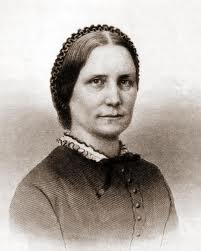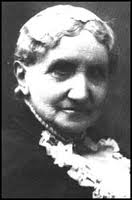 Massachusetts Abolitionist, Mary Livermore, was not only in charge of the United States Sanitary Commission in the mid-west during the Civil War, but was a righteous and outspoken Massachusetts Feminist Queen, on par with her contemporaries Clara Barton, Julia Ward Howe and Lucy Stone.
Massachusetts Abolitionist, Mary Livermore, was not only in charge of the United States Sanitary Commission in the mid-west during the Civil War, but was a righteous and outspoken Massachusetts Feminist Queen, on par with her contemporaries Clara Barton, Julia Ward Howe and Lucy Stone.
Born, Mary Ashton Rice, in Boston, Massachusetts, on December 19, 1820, her father believed in educating his daughters, and, subsequently, Livermore excelled at her studies at an early age. Also during her youth, she became devoutly religious and studied the Bible passionately. Mary worked as a teacher, including three years as a governess on a Virginia plantation, before her 1845 marriage to a Unitarian minister. The experience in the South made her an early member of the Abolition Movement, and while she mothered three children during the 1840’s and 1850’s, the family moved to Chicago in 1857, and it was from here that Mary Livermore did her important Civil War work.
She was the wife of the editor of the Chicago-based New Covenant, a Universalist publication where she also worked as an editor and writer. She covered the nomination of Abraham Lincoln at the Republican National Convention in Chicago in May 1860.
Dedicated Massachusetts abolitionist that she was, Livermore volunteered to do full-time war work soon after the Civil War began. By early 1862, she was head of the Army’s Sanitary Commission in the Midwest and was responsible for the military hospitals in Illinois, Kentucky, and Missouri. Like Barton in the East, she discovered appalling needs, and also like Barton, her genius was in supply procurement rather than in the more stereotypical nursing role that is usually assigned to Civil War women.
Her work with the Sanitary Commission led the Massachusetts born Livermore to become an active suffragist and social reformer, developing an ardent belief that extending the right to vote to women was necessary to achieving social reforms.Women volunteers, led by Livermore, literally saved the lives of thousands of men who would have died without the vital supplies they bought and sent South. Somehow in the midst of all this, Livermore found time to publish her first book, Pen Pictures, in 1863.
In November 1862 Mrs. Livermore went from Chicago to Washington, where she and some colleagues visited the President. It was Mary’s idea to convince Lincoln to donate an original of the Emancipation Proclamation to be given to her Commission for display and auction at the Sanitary Fair scheduled to be held in Chicago in November 1863.
Mary Livermore recalled a letter addressed to the Chief Executive prior to the audience with President Lincoln,
“From the first public announcement of this fair, President Lincoln took a lively interest in it. He bore testimony again and again to its moral influence, and inquired concerning its progress of every visitant from the Northwest that found his way to the White House. We wrote with much hesitation – for we never forgot how he was shouldering the woes and cares of the country – asking for some contribution from himself to our fair. The people of the Northwest were idolatrously attached to him; and we knew that any gift from him would be prized above all price. So we urged our petition as earnestly as we knew how…”
The manuscript of the Emancipation Proclamation eventually reached the Sanitary Commission Fair in Chicago, where it was displayed and auctioned for three thousand dollars. The pluck and tenacity of the Massachusetts Feminist Queen never encountered an obstacle she could not overcome.
Working with her friend, Jane Hoge, her Chicago based, Sanitary Fair eventually raised more than $70,000. Mary Livermore worked closely with Mary Ann Bickerdyke who was chief of nursing under the command of General’s Grant and Sherman during the Atlanta Campaign.
Livermore’s fund-raising speeches during the war had already shown her ability to move audiences, and she soon became a prime attraction on the lyceum circuit that provided one of the few sources of entertainment and education available in most American towns. She toured every year for more than two decades, giving thousands of speeches. Large numbers of people were thus influenced by her opinions, and they bought tickets to hear her again years later. Her topics included a range of issues, but the case for women was central to her speeches.
Not willing to merely earn a comfortable living from speaking about women’s needs, Livermore also continued as an active member of several organizations. She served as the first president of the Association for the Advancement of Women when it was founded in 1873; she was the founding president of the Women’s Christian Temperance Union (WCTU) in Massachusetts, continuing in that job from 1875-1885; she volunteered as the national president of the AWSA from 1875-1878; and she was a delegate to the International Council of Women in 1888. She played a conciliatory role when the AWSA merged with the rival National Women’s Suffrage Association in 1890 and, also that year, was a leader in the formation of the General Federation of Women’s Clubs.
Meanwhile, she continued to write, publishing her lectures and other essays in several of the nation’s best magazines. Her most popular lecture, What Shall We Do with Our Daughters? was issued in book form in 1883, and four years later she had a bestseller with her Civil War memoirs, My Story of the War, (1887). Along with Frances Willard, she edited A Woman of the Century (1893), a collection of biographical sketches of the women of her era that functioned much as a Who’s Who does today.
Mary Livermore went on to serve as president of several organizations dedicated to social reform, including the American Woman Suffrage Association (1875-1878), the Association for the Advancement of Women (1873) and the Massachusetts Woman’s Christian Temperance Union (1875-1885). She also succeeded Lucy Stone to serve as president of the Massachusetts Woman Suffrage Association (1893-1903).
Mary Livermore and her husband had moved to Melrose, Massachusetts, where they would live for the rest of their lives. Daniel became minister to the Universalist congregation in Hingham, Massachusetts, while Mary became editor of the Woman’s Journal, a suffragist paper, and began her career as a public lecturer. Over the next 25 years, she traveled the country and made several trips to Europe, delivering lectures on women’s rights, history, and religion. She estimated that she gave her most popular lecture, “What Shall We Do With Our Daughters?” over 800 times. She also wrote numerous magazine articles and several longer works, including her autobiography, “The Story of My Life.”
 Mary Livermore remained a dedicated activist in the woman suffrage movement until her death, on May 23, 1905, in Melrose, Massachusetts. One of Mary’s closest friends and admirers, Julia Ward Howe, remembered Mary,
Mary Livermore remained a dedicated activist in the woman suffrage movement until her death, on May 23, 1905, in Melrose, Massachusetts. One of Mary’s closest friends and admirers, Julia Ward Howe, remembered Mary,
“She was a prophetess of a new and better society in which dwelleth righteousness… she was also an enlivening companion, the loved and trusted friend.”
Mary Livermore was so much more than just a Massachusetts Abolitionist and humanitarian during the Civil War, she served as an example to all who knew or heard her, that women were on the verge of becoming a force to be acknowledged and reckoned with, the world over.
Bummer


What a woman!!!!!!!
Betty,
Thanks for the read. Truly a woman way in front of the curve, an inspiration to all.
Appreciate you stopping by.
Remaining,
Bummer